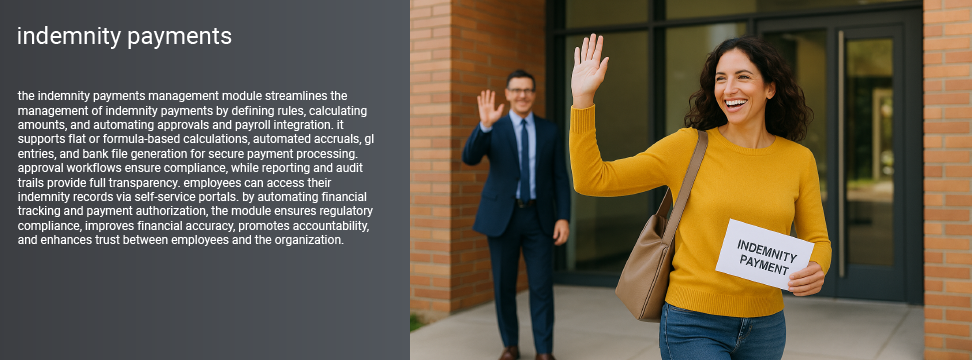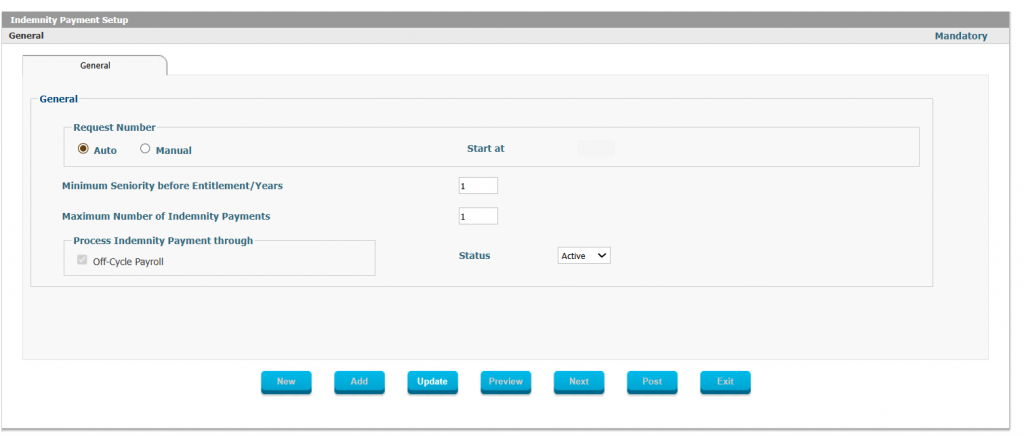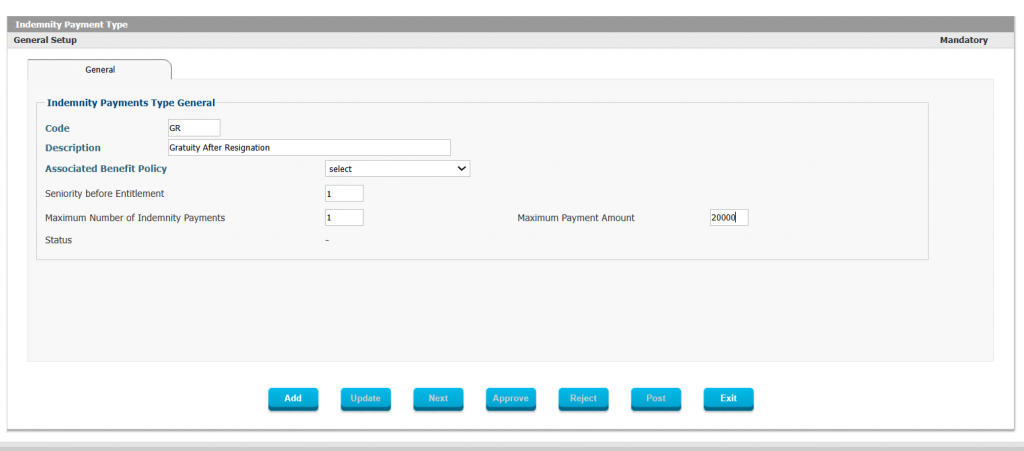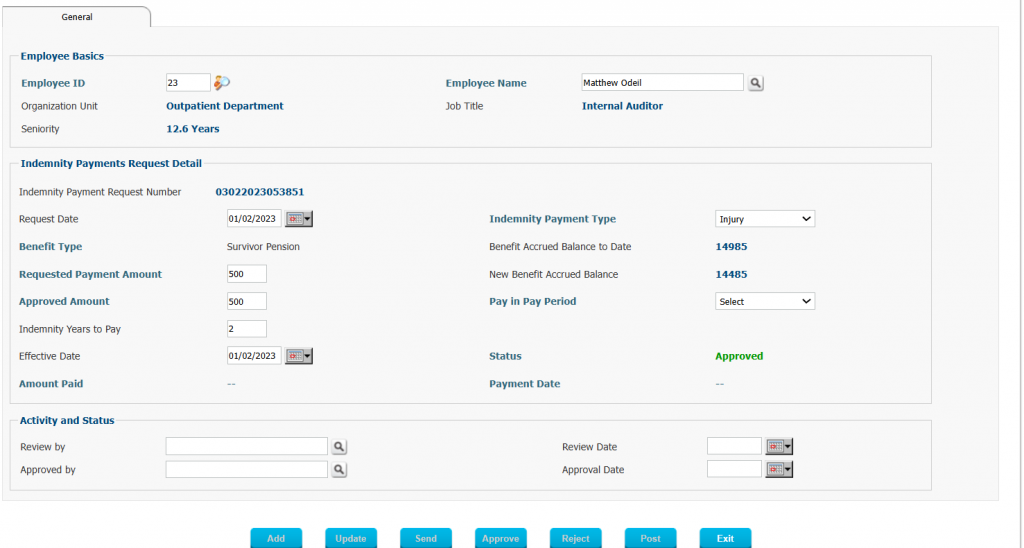Interact HRMS Indemnity Payments Management Module Overview
Figure 1: Indemnity Payment Setup
Figure 2: Indemnity Payment Type Definition
Figure 3: Indemnity Payment Request
The Interact HRMS Indemnity Payments Management module provides a structured and compliant approach to managing indemnity payments for employees. Indemnity payments are often required in specific situations, such as covering medical or legal expenses, compensating employees for employment termination (severance pay), or indemnifying against other expenses. The module enables HR teams to define rules and conditions for indemnity payments, calculate indemnity amounts accurately, and ensure proper financial tracking and reporting. With integrated payroll processing, GL (general ledger) entries, and automated bank file generation, the module streamlines the indemnity payment process, ensuring compliance with local regulations and organizational policies.
This module is especially valuable for organizations operating in regions where indemnity payments are mandated or where employer liability for certain expenses is common. By providing detailed configurations for indemnity payment rules, flexible calculation methods, and automated workflows, the module helps organizations meet their legal and financial obligations while maintaining transparency and accountability.
Defining Rules and Conditions for Indemnity Payments
The Indemnity Payments Management module allows organizations to define specific rules and conditions under which indemnity payments are made to employees. These rules are tailored to meet local regulatory requirements and align with organizational policies. Key configurations may include:
- Indemnity Triggers: Define the events that trigger indemnity payments, such as employment termination, medical expenses, or legal expenses. By specifying these triggers, the module ensures that payments are only made when appropriate conditions are met.
- Eligibility Criteria: Set eligibility requirements based on employee status, seniority, or other factors. For example, an organization might require that only employees with a certain number of years of service qualify for severance indemnity.
These rule definitions provide a structured approach to managing indemnity payments, ensuring that only eligible employees receive payments under the right circumstances. By establishing clear conditions, the module reduces the risk of errors and ensures compliance with legal requirements.
Flexible Calculation Methods for Indemnity Amounts
The module includes flexible options for calculating indemnity amounts, allowing organizations to use either a discretionary flat amount or a calculated formula. This flexibility ensures that indemnity payments align with both regulatory requirements and organizational policies. Calculation methods include:
- Flat Amount: A fixed indemnity amount that is predefined and does not vary based on individual employee factors. This option is ideal for scenarios where a standard payment amount applies.
- Formula-Based Calculation: A calculation method that uses specific parameters to determine the indemnity amount. For example, organizations can link indemnity payments to benefits policies and calculate payments based on parameters such as the employee’s last annual salary, years of service, or job classification.
These calculation options provide organizations with the flexibility to tailor indemnity payments to individual cases, promoting fairness and compliance with legal and policy requirements. The module allows HR teams to select the most appropriate calculation method for each situation, ensuring accurate and consistent payments.
Accruals and GL Entries for Financial Tracking
The Indemnity Payments Management module supports automated accruals and GL (general ledger) entries, enabling organizations to track indemnity expenses accurately in their financial systems. By accruing for indemnity payments and booking these provisions in the GL, the module ensures that all financial obligations are properly recorded, supporting financial transparency and regulatory compliance.
For instance, when an indemnity payment is anticipated (such as severance pay for an employee reaching retirement), the module automatically accrues the expected payment amount, updating the organization’s financial records. This approach ensures that funds are available when indemnity payments are due, and that all transactions are recorded accurately in the financial system. The automated GL entry process reduces the risk of accounting errors and simplifies financial reporting.
Automatic Inclusion in Payroll Processing
Once an indemnity-triggering event occurs (such as employment termination), the module allows HR teams to include the indemnity payment in the appropriate payroll run. By integrating with the Payroll module, the Indemnity Payments Management module ensures that indemnity payments are processed efficiently and appear in the employee’s payroll statement. This integration simplifies the payment process and ensures that employees receive their indemnity payments alongside other payroll items.
For example, if an employee is eligible for severance pay upon termination, the module will automatically calculate the indemnity amount, include it in the next payroll run, and generate the necessary bank files for payment processing. This seamless payroll integration supports efficient payment processing and ensures that employees receive timely compensation.
Automated Bank File Generation for Payment Processing
The module includes functionality for generating bank files automatically, allowing organizations to process indemnity payments directly through bank transfers. Once an indemnity payment is approved and included in the payroll, the module generates a bank file that can be uploaded to the organization’s banking platform for direct payment to the employee’s account. This automation reduces the need for manual intervention, ensuring that payments are made securely and accurately.
By providing automated bank file generation, the module streamlines the indemnity payment process and supports efficient fund transfers. This feature enhances convenience and accuracy, reducing the risk of delays or errors in payment processing.
Approval Workflows for Indemnity Payment Authorization
To ensure compliance and accountability, the Indemnity Payments Management module includes customizable approval workflows for indemnity payments. When an indemnity payment is calculated and ready for processing, it must go through the organization’s approval chain before finalizing. This workflow may include HR, finance, and other relevant stakeholders, providing multiple layers of review to confirm the payment’s accuracy and compliance.
Approval workflows enhance control over indemnity payments, ensuring that only authorized transactions are processed. By involving multiple stakeholders, the module promotes transparency and accountability in indemnity management, reducing the risk of unauthorized or incorrect payments.
Powerful Reporting and Audit Trails for Transparency
The module offers robust reporting and audit trail features, allowing HR and finance teams to review indemnity payment records and verify compliance. Reports can be generated to show details of all indemnity payments, including the payment amount, recipient, reason for payment, and approval status. These reports support internal audits, financial reviews, and regulatory reporting, ensuring that indemnity payments are documented thoroughly.
Audit trails provide a record of all actions taken within the module, including calculation details, payment approvals, and changes made to payment records. This audit trail supports transparency and allows organizations to demonstrate compliance with legal and financial obligations. By providing a clear record of indemnity payments, the module ensures that all transactions can be traced and verified if necessary.
Employee Access to Indemnity Payment Records
The module supports employee access to indemnity payment records through the self-service portal, allowing employees to view their indemnity payments, payment history, and other related details. This transparency ensures that employees understand their entitlements and can access payment records for their financial planning.
By providing self-service access, the module enhances the employee experience and builds trust in the organization’s indemnity management practices. Employees can view the details of their indemnity payments without needing to contact HR, supporting a user-friendly approach to financial transparency.
Summary: Interact HRMS Indemnity Payments Management
The Interact HRMS Indemnity Payments Management module provides organizations with a structured, compliant solution for managing indemnity payments. Key benefits include:
- Rule and Condition Definition: Define specific rules and conditions for indemnity payments, ensuring eligibility and regulatory compliance.
- Flexible Calculation Methods: Use flat amounts or formula-based calculations for customized indemnity amounts.
- Accruals and GL Entries: Track indemnity expenses accurately in the financial system with automated accruals and GL entries.
- Automatic Payroll Inclusion: Integrate indemnity payments with payroll processing for timely employee compensation.
- Automated Bank File Generation: Generate bank files for direct payment processing, ensuring secure and efficient transfers.
- Approval Workflows: Ensure compliance and accountability with customizable approval workflows for indemnity payments.
- Comprehensive Reporting and Audit Trails: Access detailed reports and audit trails for internal review and regulatory compliance.
- Employee Access to Payment Records: Empower employees with self-service access to indemnity payment details.
By combining these features, the Indemnity Payments Management module enables organizations to manage indemnity payments efficiently, transparently, and in compliance with legal requirements. This structured approach supports financial accuracy, promotes accountability, and enhances employee trust in the organization’s indemnity management practices.




